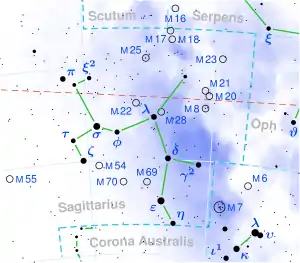Tau Sagittarii
Tau Sagittarii (Tau Sgr, τ Sagittarii, τ Sgr) is a star in the southern zodiac constellation of Sagittarius.
 | |
| Observation data Epoch J2000.0 Equinox J2000.0 | |
|---|---|
| Constellation | Sagittarius |
| Right ascension | 19h 06m 56.40897s[1] |
| Declination | –27° 40′ 13.5189″[1] |
| Apparent magnitude (V) | +3.326[2] |
| Characteristics | |
| Spectral type | K1 III[3] |
| U−B color index | +1.185[2] |
| B−V color index | +1.170[2] |
| Astrometry | |
| Radial velocity (Rv) | +45.4[4] km/s |
| Proper motion (μ) | RA: –50.61[1] mas/yr Dec.: -249.80[1] mas/yr |
| Parallax (π) | 28.3195 ± 0.3134 mas[5] |
| Distance | 115 ± 1 ly (35.3 ± 0.4 pc) |
| Absolute magnitude (MV) | 0.48[6] |
| Details[7] | |
| Mass | 1.25 M☉ |
| Radius | 15.71 R☉ |
| Luminosity | 87.6 L☉ |
| Surface gravity (log g) | 2.15 cgs |
| Temperature | 4,459 K |
| Metallicity [Fe/H] | –0.27 dex |
| Rotational velocity (v sin i) | 1.04[8] km/s |
| Age | 7.91 Gyr |
| Other designations | |
| Database references | |
| SIMBAD | data |
Description
With an apparent visual magnitude of +3.3,[2] this is one of the brighter members of the constellation. The distance of this star from Earth is roughly 122 light-years (37 parsecs), based upon parallax measurements.[1]
This is a spectral type K1 giant star with about 1.25 M☉. The stellar envelope is slightly cooler than the Sun with an effective temperature of 4,459 K, giving the star a light orange color. The interferometry-measured angular diameter of this star, after correcting for limb darkening, is 3.93 ± 0.04 mas,[9] which, at its estimated distance, equates to a physical radius of about 16 times the radius of the Sun.[10]
τ Sagittarii is a suspected double star although no companion has been confirmed yet. A lower metal content (Fe to H ratio is 54% lower than the sun's) and a high peculiar velocity (64 km/s, four times the local average) relative to the Sun suggest the star is a visitor from a different part of the Galaxy.
τ Sagittarii is a red clump giant, a star with a similar mass to the sun which has exhausted its core hydrogen, passed through the red giant branch, and started helium fusion in its core.[11]
The Wow! signal
τ Sagittarii is the closest constellational star (a star that is part of the traditional outline of a constellation) to the origin of the 1977 Wow! signal.[12]
Name and etymology
- The star forms part of simple asterisms:
- γ Sgr, τ Sgr, δ Sgr, ε Sgr, ζ Sgr, λ Sgr, σ Sgr and φ Sgr — the Teapot.[13]
- φ Sgr, τ Sgr, ζ Sgr, χ Sgr (double) and σ Sgr — the Returning Ostriches; in Arabic Al Naʽām al Ṣādirah often transliterated as Namalsadirah (النعم السادرة).[14]
- ν Sgr, τ Sgr, ψ Sgr, ω Sgr, 60 Sgr and ζ Sgr, Al Udḥiyy — the Ostrich's Nest.[14]
- In the entirely separate Chinese tradition — 斗 (Dǒu), meaning Dipper: τ Sgr, φ Sgr, λ Sgr, μ Sgr, σ Sgr and ζ Sgr. The star itself is 斗宿五 (Dǒu Sù wu, English: the Dipper's fifth star).[16]
References
- van Leeuwen, F. (November 2007), "Validation of the new Hipparcos reduction", Astronomy and Astrophysics, 474 (2): 653–664, arXiv:0708.1752, Bibcode:2007A&A...474..653V, doi:10.1051/0004-6361:20078357, S2CID 18759600
- Celis S., L. (October 1975), "Photoelectric photometry of late-type variable stars", Astronomy and Astrophysics Supplement Series, 22: 9–17, Bibcode:1975A&AS...22....9C
- Gray, R. O.; et al. (July 2006), "Contributions to the Nearby Stars (NStars) Project: spectroscopy of stars earlier than M0 within 40 pc-The Southern Sample", The Astronomical Journal, 132 (1): 161–170, arXiv:astro-ph/0603770, Bibcode:2006AJ....132..161G, doi:10.1086/504637, S2CID 119476992
- Wilson, R. E. (1953). General Catalogue of Stellar Radial Velocities. Carnegie Institute of Washington D.C. Bibcode:1953GCRV..C......0W.
- Brown, A. G. A.; et al. (Gaia collaboration) (2021). "Gaia Early Data Release 3: Summary of the contents and survey properties". Astronomy & Astrophysics. 649: A1. arXiv:2012.01533. Bibcode:2021A&A...649A...1G. doi:10.1051/0004-6361/202039657. S2CID 227254300. Gaia EDR3 record for this source at VizieR.
- Cardini, D. (January 2005), "Mg II chromospheric radiative loss rates in cool active and quiet stars", Astronomy and Astrophysics, 430: 303–311, arXiv:astro-ph/0409683, Bibcode:2005A&A...430..303C, doi:10.1051/0004-6361:20041440, S2CID 12136256.
- Reffert, Sabine; et al. (2015). "Precise radial velocities of giant stars. VII. Occurrence rate of giant extrasolar planets as a function of mass and metallicity". Astronomy & Astrophysics. 574: A116. arXiv:1412.4634. Bibcode:2015A&A...574A.116R. doi:10.1051/0004-6361/201322360. hdl:10722/215277. S2CID 59334290.
- Hekker, S.; Meléndez, J. (2007). "Precise radial velocities of giant stars. III. Spectroscopic stellar parameters". Astronomy and Astrophysics. 475 (3): 1003. arXiv:0709.1145. Bibcode:2007A&A...475.1003H. doi:10.1051/0004-6361:20078233. S2CID 10436552.
- Richichi, A.; et al. (February 2005), "CHARM2: An updated Catalog of High Angular Resolution Measurements", Astronomy and Astrophysics, 431 (2): 773–777, Bibcode:2005A&A...431..773R, doi:10.1051/0004-6361:20042039
- Lang, Kenneth R. (2006), Astrophysical formulae, Astronomy and astrophysics library, vol. 1 (3rd ed.), Birkhäuser, ISBN 3-540-29692-1. The radius (R*) is given by:
- Alves, David R. (2000). "K-Band Calibration of the Red Clump Luminosity". The Astrophysical Journal. 539 (2): 732–741. arXiv:astro-ph/0003329. Bibcode:2000ApJ...539..732A. doi:10.1086/309278. S2CID 16673121.
- "The world's biggest mysteries scientists still can't solve". 2 September 2014.
- "Teapot". constellation-guide.com. Retrieved 2017-05-13.
- Allen, R. H. (1963). Star Names: Their Lore and Meaning (Reprint ed.). New York: Dover Publications Inc. p. 355. ISBN 0-486-21079-0. Retrieved 2012-09-04.
- Jack W. Rhoads - Technical Memorandum 33-507 - A Reduced Star Catalog Containing 537 Named Stars, Jet Propulsion Laboratory, California Institute of Technology; November 15, 1971
- (in Chinese) AEEA (Activities of Exhibition and Education in Astronomy) 天文教育資訊網 2006 年 5 月 11 日